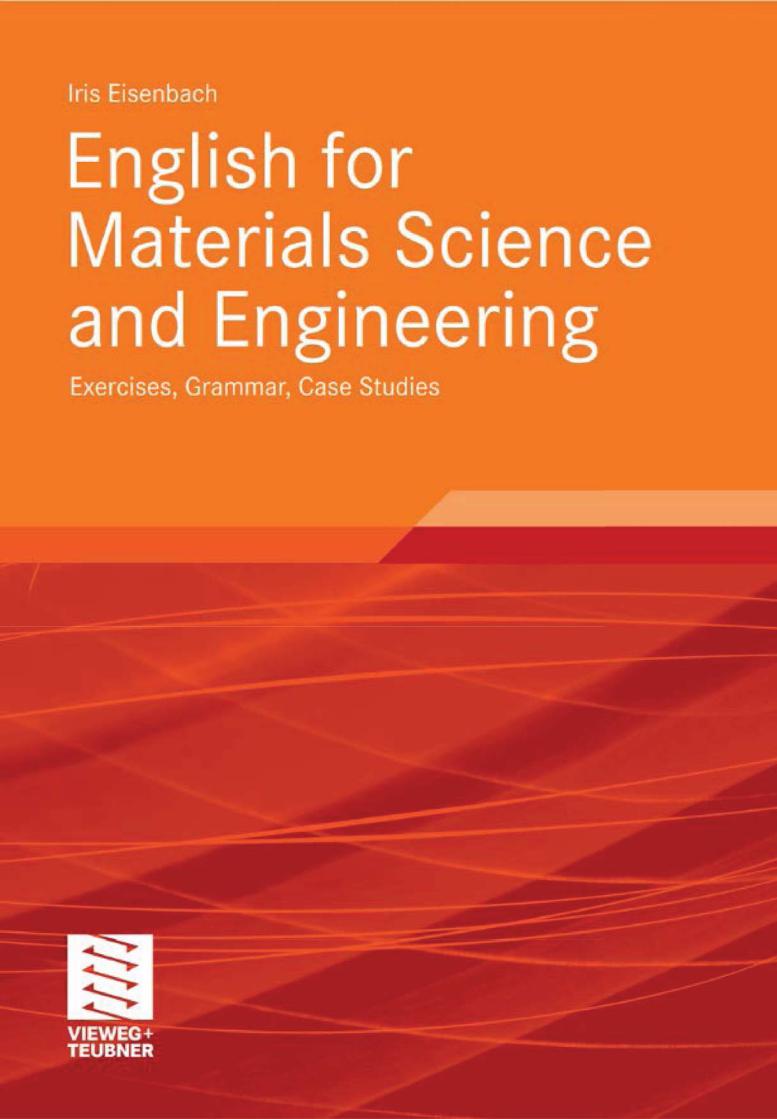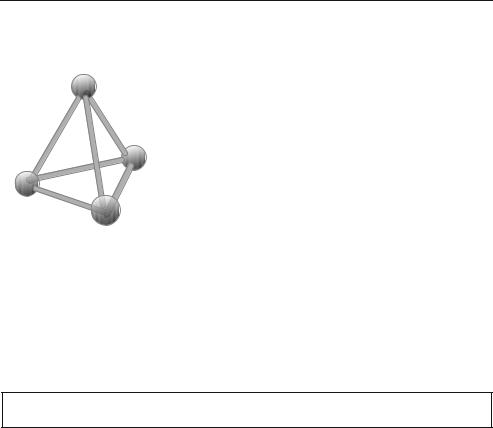
English_Materials_Science_no_answers
.pdf
Iris Eisenbach
English for Materials Science and Engineering

Iris Eisenbach
English for Materials Science and Engineering
Exercises, Grammar, Case Studies

Bibliographic information published by the Deutsche Nationalbibliothek
The Deutsche Nationalbibliothek lists this publication in the Deutsche Nationalbibliografie; detailed bibliographic data are available in the Internet at http://dnb.d-nb.de.
Iris Eisenbach has extensive experience in teaching all levels of English to speakers of other languages and for a wide range of educational and professional purposes. The author graduated in English and French from the University of Mainz and from the Teacher Training College (Studienseminar) in Wiesbaden, (both Germany) with the Second State Examination. After teaching foreign languages to students at different levels for some years, she got tenure as a civil servant (Oberstudienrätin). Iris Eisenbach has spent the past 20 years concentrating on teaching English to students in university settings. Presently she is working as a university language instructor at the English and German Departments of the Language Center of the University of Stuttgart, Germany.
1st Edition 2011
All rights reserved
© Vieweg +Teubner Verlag | Springer Fachmedien Wiesbaden GmbH 2011
Editorial Office: Imke Zander | Thomas Zipsner
Vieweg+Teubner Verlag is a brand of Springer Fachmedien.
Springer Fachmedien is part of Springer Science+Business Media.
www.viewegteubner.de
No part of this publication may be reproduced, stored in a retrieval system or transmitted, in any form or by any means, electronic, mechanical, photocopying, recording, or otherwise, without the prior written permission of the copyright holder.
Registered and/or industrial names, trade names, trade descriptions etc. cited in this publication are part of the law for trade-mark protection and may not be used free in any form or by any means even if this is not specifically marked.
Cover design: KünkelLopka Medienentwicklung, Heidelberg Layout: Stefan Kreickenbaum, Wiesbaden
Pictures: Graphik & Text Studio, Dr. Wolfgang Zettlmeier, Barbing; Stefan Kreickenbaum, Wiesbaden Printed on acid-free paper
Printed in Germany
ISBN 978-3-8348-0957-5

V
Introduction
This textbook is intended for students of materials science, of different branches of engineering and of related disciplines who need to re-activate their English language skills. Using authentic materials and figures selected from scientific texts, students will improve their reading, writing and speaking skills in a context relevant to their specialist studies. This work does not attempt to teach the subject of materials science.
In addition to covering linguistic features specific to scientific and technical purposes, this book also presents review and practice activities in common problem areas of general English usage. The material for the textbook has been developed and tested in classes at the English Department of the University of Stuttgart over several semesters, and it addresses most of the problems English-language learners confront.
Students’ feedback has been incorporated into the textbook; the author gratefully acknowledges these contributions, which make the book useful for successful teaching and self-study purposes.
Since the book is designed as both textbook and workbook, it is suitable for classroom use and for self-study. It contains extensive monolingual glossaries, tasks, grammar reviews and word studies directly related to the texts and figures. Solutions are offered in the back of the book.
The textbook offers sufficient material for a one-semester language class of about 14 sessions. Subjects, grammar reviews and word studies can also be studied independently.
Acknowledgements
This book would never have been written without the support of the Materials Research Laboratory (MRL) of the University of California, Santa Barbara, where I was accompanying my husband, Professor Claus D. Eisenbach, in 2007–2008. I am very grateful to the MRL for kindly offering me the use of the visiting scholar’s office and for providing equipment and support.
The MRL also made it possible for me to attend classes by two excellent researchers and dedicated teachers, Professor Ram Seshadri and Professor Susanne Stemmer. Professor Seshadri in particular introduced me to the field of materials science and directed me to my most valuable source, Materials Science and Engineering: An Introduction, by William D. Callister Jr.
I am also indebted to my husband who was a constant source of knowledge and expertise and who read and commented on the manuscript. Special thanks to my good friend Pamela Lavigne, whose experience in TESOL (Teaching English to Speakers of Other Languages) and in editing were of great help. I am likewise grateful to the editors of “Lektorat Maschinenbau” at Vieweg+Teubner for their technical assistance.
Stuttgart, Autumn 2010 |
Iris Eisenbach |

VII
Table of contents
Chapter 1 Introduction .................................................................................................... |
1 |
|
1.1 |
Historical Background ......................................................................................... |
1 |
1.2 |
Grammar: Simple Past versus Present Perfect ..................................................... |
3 |
1.3 |
Materials Science versus Materials Engineering ................................................. |
5 |
1.4 |
Selection of Materials .......................................................................................... |
6 |
1.5 |
Some Phrases for Academic Presentations .......................................................... |
7 |
1.6 |
Case Study: The Turbofan Aero Engine .............................................................. |
8 |
1.7 |
Some Abbreviations for Academic Purposes ...................................................... |
10 |
Chapter 2 Characteristics of Materials .......................................................................... |
12 |
|
2.1 |
Structure .............................................................................................................. |
12 |
2.2 |
Some Phrases for Academic Writing ................................................................... |
13 |
2.3 |
Case Study: The Gecko ....................................................................................... |
15 |
2.4 |
Property ............................................................................................................... |
16 |
2.5 |
Some Phrases for Describing Figures, Diagrams and for Reading Formulas ...... |
19 |
2.6 |
Grammar: Comparison ........................................................................................ |
20 |
2.7 |
Processing and Performance ................................................................................ |
21 |
2.8 |
Classification of Materials ................................................................................... |
23 |
2.9 |
Grammar: Verbs, Adjectives, and Nouns followed by Prepositions ................... |
24 |
Chapter 3 Metals .............................................................................................................. |
25 |
|
3.1 |
Introduction ......................................................................................................... |
25 |
3.2 |
Mechanical Properties of Metals ......................................................................... |
27 |
3.3 |
Important Properties for Manufacturing .............................................................. |
29 |
3.4 |
Metal Alloys ........................................................................................................ |
30 |
3.5 |
Case Study: Euro Coins ....................................................................................... |
32 |
3.6 |
Grammar: Adverbs I ............................................................................................ |
34 |
3.7 |
Case Study: The Titanic ...................................................................................... |
35 |
3.8 |
Grammar: The Passive Voice .............................................................................. |
36 |
3.9 |
Case Study: The Steel-Making Process ............................................................... |
38 |
Chapter 4 Ceramics ......................................................................................................... |
40 |
|
4.1 |
Introduction ......................................................................................................... |
40 |
4.2 |
Structure of Ceramics .......................................................................................... |
41 |
4.3 |
Word Formation: Suffixes in Verbs, Nouns and Adjectives ............................... |
41 |
4.4 |
Properties of Ceramics ......................................................................................... |
43 |
4.5 |
Case Study: Optical Fibers versus Copper Cables ............................................... |
44 |
4.6 |
Grammar: Adverbs II ........................................................................................... |
46 |
4.7 |
Case Study: Pyrocerams ...................................................................................... |
46 |
4.8 |
Case Study: Spheres Transporting Vaccines ....................................................... |
48 |
4.9 |
Useful Expressions for Shapes and Solids .......................................................... |
49 |

VIII |
|
Table of contents |
Chapter 5 Polymers .......................................................................................................... |
51 |
|
5.1 |
Introduction ......................................................................................................... |
51 |
5.2 |
Word Formation: The Suffix -able/-ible .............................................................. |
52 |
5.3 |
Properties of Polymers ......................................................................................... |
53 |
5.4 |
Case Study: Common Objects Made of Polymers ............................................... |
54 |
5.5 |
Case Study: Ubiquitous Plastics .......................................................................... |
55 |
5.6 |
Grammar: Reported Speech (Indirect Speech) .................................................... |
57 |
5.7 |
Polymer Processing ............................................................................................. |
59 |
5.8 |
Case Study: Different Containers for Carbonated Beverages .............................. |
61 |
Chapter 6 Composites ...................................................................................................... |
63 |
|
6.1 |
Introduction ......................................................................................................... |
63 |
6.2 |
Case Study: Snow Ski .......................................................................................... |
64 |
6.3 |
Grammar: Gerund (-ing Form) ............................................................................ |
66 |
6.4 |
Case Study: Carbon Fiber Reinforced Polymer (CFRP) ..................................... |
69 |
6.5 |
Word Formation: Prefixes ................................................................................... |
70 |
Chapter 7 Advanced Materials ....................................................................................... |
73 |
|
7.1 |
Introduction ......................................................................................................... |
73 |
7.2 |
Semiconductors .................................................................................................... |
75 |
7.3 |
Case Study: Integrated Circuits ........................................................................... |
76 |
7.4 |
Grammar: Subordinate Clauses ........................................................................... |
77 |
7.5 |
Smart Materials .................................................................................................... |
78 |
7.6 |
Nanotechnology ................................................................................................... |
80 |
7.7 |
Case Study: Carbon Nanotubes ........................................................................... |
80 |
7.8 |
Grammar: Modal Auxiliaries ............................................................................... |
82 |
KEY .................................................................................................................................... |
|
84 |
Credits/Selected Reference List ........................................................................................ |
104 |
|
Glossary |
.............................................................................................................................. |
106 |

1
Chapter 1 Introduction
Structure
Properties
Processing
Performance
Figure 1: Materials science tetrahedron [wikipedia]
1.1 Historical Background
Task 1. Work with a partner. Fill the gaps in the text with words from the box in their correct form.
alloy; characteristic; communication; clay; crystal; heat; housing; manipulate; metal; pottery; property (2); skin; specimen; substance; structure; technological; wood
Materials used in food, clothing, ……………………….…………………………., transportation, recreation and
……………………….……………………….. influence virtually every segment of our everyday lives. Historically, materials have played a major role in the development of societies, whose advancement depended on their access to materials and on their ability to produce and
……………………….……………………..…. them. In fact, historians named civilizations by the level of their materials development, e.g. the Stone Age (beginning around 2.5 million BC), the Bronze Age (3500 BC), and the Iron Age (1000 BC). The earliest humans had access to only a very limited number of materials, those that occur naturally, e.g. …………………………………………….….,
……………………….………………………. and …………………………………………….….. With time they discovered tech-
niques for producing materials that had properties superior to those of the natural ones; these
new materials included ………………………………………….……. and various ………………………………….……………..
Furthermore, early humans discovered that the properties of a material could be altered
I. Eisenbach, English for Materials Science and Engineering, DOI 10.1007/978-3-8348-9955-2_1, © Vieweg+Teubner Verlag | Springer Fachmedien Wiesbaden GmbH 2011
